A Year With a New-Scout Patrol
By Cathleen Ann Steg
Illustrations By Joel Snyder
After joining Troop 1113 as graduating Webelos Scouts, the Tree Frog Patrol goes from novice to knowledgeable in 12 well-planned months of exciting troop adventures.
What's so special about new-Scout patrols? Why should a troop keep its new boys together in their own patrol during their first year, instead of mixing them in with older boys of all ranks?
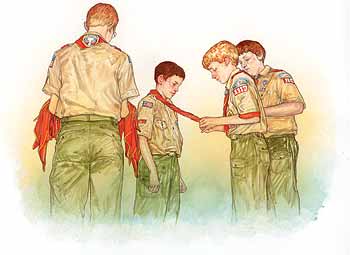 Older Scouts Bryce Jones (holding neckerchiefs), Joe DeSantis, and Justin Frazier welcome a new Scout into Troop 1113. |
After spending a year with a Fairfax, Va., troop with a great program for new Scouts, I know what makes this program work well. It's a combination of good planning, quality junior leadership, and effective use of the boy-led troop concept by adult leaders.
To find out what I learned following these first-year Scouts, lace up your hiking boots and walk their trail with me.
Focus on preparation
Troop 1113, with a membership of 70 boys, is chartered to the Knights of Columbus of St. Leo the Great Catholic Church. That is in the National Capital Area Council's George Mason District.
"We believe in the new-Scout patrol because it just works best for us," says former committee chairman Bob Malloy. And each year, to ensure the program's success, troop leaders carefully plan for the arrival of the newest group of boys graduating from Webelos Scouting to Boy Scouting.
Preparation includes updating a key tool for the new-Scout program: the troop's "red folder," a special booklet prepared for each new family [see the sidebar].
The program also succeeds because Troop 1113 pays close attention to the importance of boy leadership. Troop guides—the older Scouts who serve as mentors and advisers for new-Scout patrols—are recommended by Scoutmaster Dick DeiTos for their qualities of patience, maturity, and sense of fun.
"The position of troop guide is just too important to leave to chance," DeiTos explains.
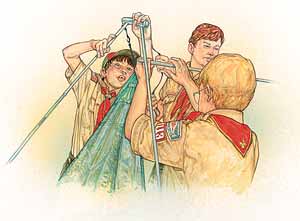 To prepare for their first camp-out, the Tree Frogs participate in a tent-pitching race during a troop meeting. |
Besides the troop guides, the other junior leaders also understand the importance of starting the new boys off well. In preparation, the midwinter patrol leaders' council meeting focuses on ways to ease the new Scouts into the troop.
"It's vital to prepare a careful agenda," notes Andrew Janeiro, a former senior patrol leader getting ready to serve as a troop guide. "We hope to help them develop character and leadership skills, so when we're not around, they'll be able to run things themselves."
At the troop committee's March 2003 meeting, Andrew previews a PowerPoint presentation that he has created for the new boys' first meeting. It's full of important Scouting information, from badges of rank to a chart showing the chain of command, to scenes from past camp-outs, and an explanation of the Outdoor Code.
"We've been blessed," says Scoutmaster Dick DeiTos, in remarking on the quality of Andrew's presentation and the efforts of his other junior leaders as well. "Tonight was the first time I saw that presentation, which was all Andrew's idea. And that's an example of how our boy leaders take the initiative and develop their own program."
The first meetings
Most of the Webelos Scouts joining the troop in the spring of 2003 come from Pack 1113 (which is also chartered to St. Leo's), but some others come from a neighboring pack. Their crossover ceremony, where they graduate from Cub Scouting and are officially welcomed into Troop 1113, takes place during a March pack meeting in the gym at St. Leo's.
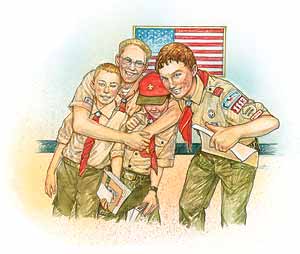 At their first meeting, new Scouts Andrew Rosenberger and Graham Smith (with hat) are welcomed by troop veterans Jim Grasmeder and Mike Speed. |
The new boys sit on blankets on the gym floor, amusing themselves with a game of "rock, paper, scissors" as they wait for the ceremony to begin.
They seem so young, so much in need of careful handling.
"It's a bittersweet moment," observes Pack 1113 Webelos den leader Pat Corcoran as she watches her departing den members—including her son, Teige—cross over a ceremonial bridge, to be greeted by Order of the Arrow team members Mike Speed, Matt Roy, and Jim Grasmeder. "It's hard to let them go," she says, as each new Scout is presented with Troop 1113's red neckerchief.
A week later, the former Webelos Scouts attend their first troop meeting as Boy Scouts.
The opening activities are designed to help the new boys feel at home. In one, each new Scout stands before the troop, introduces himself and then tells two truths and one "nontruth" about himself.
"It's not lying; it's really all right," jokes junior assistant Scoutmaster Matt Roy to one worried boy.
Troop members then vote on which of the three statements is false.
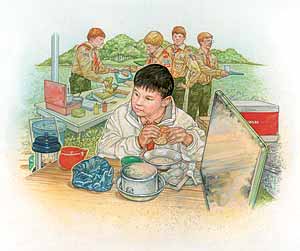 Michael Raffels (foreground) enjoys some of Bryce Jones's breakfast cooking skills. |
After announcing his name, new Scout Joe McGiffin states: "I have a dog; I play a musical instrument, the baritone; and I like chocolate ice cream." (No one guesses the nontruth; "I don't really like chocolate ice cream," Joe reveals.)
During a separate "pull-out" session (a regular segment for new-Scout patrols at each troop meeting), Andrew Janeiro offers his PowerPoint presentation.
Andrew and Matt Roy then turn into a comedy team, giving a talk on basic camping skills peppered with quips, such as, "Think of most toiletries as optional on this camp-out; we don't care what you smell like!" and "Don't bring good stuff, electronics, cashmere sweaters, cell phones. We don't think your girlfriend's going to call you this weekend."
"It's a challenge to work with young Scouts," admits troop guide Bryce Jones. "But we try to bring the new boys in right away, especially the ones who are not from Pack 1113 here at St. Leo's."
Bryce is serving as troop guide for the new Scouts from Pack 1113. During the patrol meeting segment at the next troop meetings, he offers them competitions, games, and "things with a Cub Scout feel; we make a gradual transition to bigger expectations as the new Scouts develop skills."
One opportunity to bond as a new patrol is selecting the patrol name. The Scouts choose Tree Frogs and set about designing a flag. ("You'll want to make a tree frog look fierce," Bryce advises.)
In April at the troop meeting before their first camp-out, the Tree Frogs focus on an important skill—how to pitch the troop's tents. As they struggle with poles and nylon, Bryce offers tips on many details, such as the best way to put in the stakes: "Work as a team, putting in the pegs on all sides at the same time."
So good, so soon
In May the new Scouts go on their first long-distance overnight camp-out, a rain-soaked visit to Gettysburg, Pa. A springtime downpour has drowned the grassy campsite under six inches of water and, concerned that the conditions will overwhelm the novice campers, I fear the weekend will be a disaster.
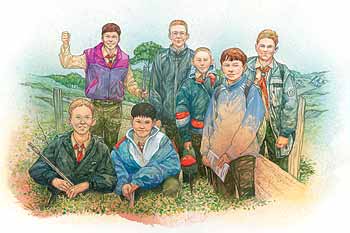 Despite the wet conditions, the Tree Frogs showed spirit during their Gettysburg camp-out. |
But the aptly named Tree Frogs aren't daunted by the horrific weather. Thanks to good instruction at troop meetings, they work as a team and, despite the squishy ground, raise a patrol tarp in short order.
They still don't know everything, though. For example, as soon as the tarp is up, one boy wonders: "How many tents are we supposed to fit under this thing?"
Once that issue is clarified, the boys move a picnic table under the tarp, pile their patrol supplies on it, set up their own tents, and stash their personal gear—all within an hour and 15 minutes.
Most remarkable about the camp setup is that no adult leader enters the site. Later, troop guides Bryce Jones and Gregory Connelly happily report to the adult leaders' campsite that the Tree Frogs needed no help; they have done it all.
This pattern continues the next morning, when the patrol awakes at 5:30 a.m. to the loud singing of a resident bird.
The smell of breakfast drifts over from the adults' campsite, inspiring the Tree Frogs to set up their Coleman stove and begin learning some secrets of camp cooking.
The lessons begin with Bryce showing Raymond Donahue how to crack eggs without breaking the yolks. As if on cue, the rain finally stops when the eggs are cooked, served on biscuits with sausage.
Before eating, however, each Scout receives a liberal dose of waterless hand cleaner. ("Why do we have to use this stuff?" one boy wonders. "Because it's sanitary," replies Bryce. "Mandatory?" the boy asks. "Yeah, that, too.")
Making a good thing better
Summer camp is an important part of Troop 1113's program year. The former Webelos Scouts had attended Goshen Scout Reservation, the National Capital Area Council's camp, the previous summer. But in 2003, the troop attends Camp Powhatan in Virginia's Blue Ridge Mountains Council. The Tree Frogs are enrolled in the camp's Brownsea Island Adventure program for new Scouts.
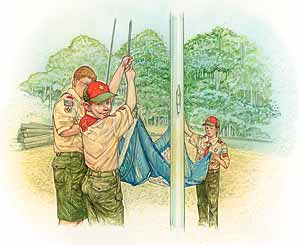 At summer camp, new Scouts Matt Hogan (left) and Nathan Hahn assist Danny McGiffin (without hat) during the flag-raising ceremony. |
At camp, staff member Bradley Long, a freshman at King College in Bristol, Tenn., serves as troop guide for the patrol. "The Brownsea Island program will help to solidify the skills they've been taught in the troop," he says.
Long is a believer in the value of practice, from flag-folding to learning to explain the points of the Scout Law. Noting that it's not enough to practice something just once at a troop meeting, he encourages the boys to keep improving their knowledge and skills during their June week at Camp Powhatan.
Another benefit for the patrol at summer camp is the opportunity to experience leadership responsibility. Each day a different boy serves in the patrol leader and assistant patrol leader positions.
Taking on challenges, developing leadership, and acquiring new skills are vital to any new-Scout patrol, but Long teaches that creating a patrol spirit is also important.
And the Tree Frogs' spirit gets a mega-boost when it's announced that they are the first patrol to earn Brownsea's coveted "Golden Stave" award. The award recognizes their interest in Baden-Powell lore, a desire to learn Scout skills, good sportsmanship, and some awe-inspiring lung power during the camp cheering session.
Next!
In the months following summer camp, the new-Scout patrol focuses on learning skills needed to pass specific rank requirements.
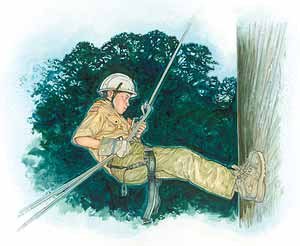 Summer camp offered opportunities for exciting adventures, like descending the rappelling tower. |
By the end of the year, most of the new Scouts have made First Class, their progress helped in part by programs at troop meetings and outings, like the November hike in Prince William Forest Park in Northern Virginia. On the hike, the boys work with their leaders to hone map and compass skills and to identify plants in the wild. As always, though, the hard work is blended with a dose of fun, as the boys compete in attempting to leap across a stream.
By January 2004, a change is in the air in the parish hall. The Tree Frogs are about to complete one year as Scouts, and a new group of Webelos Scouts is visiting the troop's annual open house.
Bryce Jones takes 25 visitors off to a separate room, leaving his former charges behind to mingle with the older boys in the troop.
It's clear they are no longer beginners, as Teige Corcoran, Michael Raffels, and other Tree Frogs spend the evening as confident, experienced, full-fledged participants, helping the older boys run a video camera to make a movie for the Cinematography merit badge.
Before the latest Webelos Scouts join the troop, the Tree Frog Patrol will dissolve, its members joining other patrols in Troop 1113.
And the troop's adults and junior leaders will congratulate themselves on a job well done.
Contributing editor Cathleen Ann Steg lives in Fairfax, Va.
A Special Year for New ScoutsA new-Scout patrol is for 11-year-old Scouts who have recently joined the troop. They function together as a patrol during their first year in the troop, working toward the goal of completing the requirements for First Class. With the advice and consent of the assistant Scoutmaster assigned to work with the new-Scout patrol, an older, experienced Scout is appointed by the senior patrol leader to serve as troop guide for the new-Scout patrol. Acting both as a leader and mentor, this experienced Scout (who must be at least First Class in rank) helps the new Scouts through the early challenges of troop membership. He provides direction, coaching, and support as determined by the skill level and morale of the members of the new-Scout patrol. The troop guide is a member of the patrol leaders' council. Although he usually is not a member of another patrol, he may participate in activities of a Venture patrol. During troop meetings, new Scouts have separate instruction sessions and patrol meetings. A description of the content and activities for these sessions (along with separate sessions for experienced Scouts and older Scouts) is included in the weekly troop meeting plans found in the 36 segments in the three volumes of Troop Program Features (BSA Nos. 33110A, 33111, and 33112). In addition to the three printed volumes, five of the six issues of Scouting magazine that are sent to Boy Scout unit leaders and commissioners each year contain a total of 12 Troop Program Features, each one recommended for a specific month. |
Tips for a Successful ProgramTroop 1113 Scoutmaster Dick DeiTos offers these top five tips to anyone organizing a new-Scout patrol:
—C.A.S. |
Inside the 'Red Folder'An information packet for new Scouts and their parents would seem like a commonsensical idea. However, in many years as an active Scouter, I have seen more troops without a quality package than with one. Troop 1113's Parent's Guide, referred to as the "red folder," ranks among the best I've seen. Updated every year, it includes the following:
—C.A.S. |
May - June 2004 Table of Contents
Copyright © 2004 by the Boy Scouts of America. All rights thereunder reserved; anything appearing in Scouting magazine or on its Web site may not be reprinted either wholly or in part without written permission. Because of freedom given authors, opinions may not reflect official concurrence.